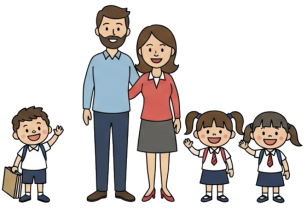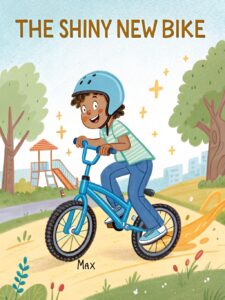
Question More, Action Knowledge.
Remember, at QMAK, we don’t just teach; we empower. We don’t just inform; we inspire. We don’t just question; we act. Become a Gold Member, and let’s unlock your child’s full potential, one question at a time.

Once upon a time, there was a boy named Max who loved collecting things. His room was filled with toys, games, and books – many barely used because Max was always excited about getting something new.
One Saturday morning, Max’s parents surprised him with a blue bicycle he’d been asking for.
“This is the BEST BIKE EVER!” Max shouted, racing outside to ride it around the neighborhood.
For a whole week, Max rode his blue bike everywhere. He named it “Lightning” and told everyone at school about his amazing new bike.
But then, Max saw his neighbor Olivia riding a red bicycle with cool silver streamers and a basket.
“Your bike looks so much better than mine,” Max sighed. “Mine is boring now.”
That night at dinner, Max asked his parents, “Can I get a new bike? Maybe a red one with streamers and a basket?”
Dad looked surprised. “But Lightning is only a week old! What happened to it being the ‘best bike ever’?”
Grandpa, who was visiting for dinner, smiled knowingly. “Sounds like Max is experiencing novelty bias.”
“What’s that?” Max asked.
“It’s when our brains get extra excited about new things,” Grandpa explained. “It’s like how a new song on the radio sounds amazing at first, but after hearing it twenty times, it’s just another song.”
“But Olivia’s bike really is better,” Max insisted.
“Let’s try something,” said Grandpa. “Tomorrow, let’s make your current bike feel new again instead of getting another one.”
The next day, Grandpa brought over some bike tools, streamers, stickers, and a small bell. Together, they spent the afternoon customizing Lightning. They added blue and silver streamers, lightning bolt stickers, and a shiny bell that made a pleasant ring.
“Wow!” Max exclaimed when they finished. “Lightning looks amazing!”
“And here’s something else,” Grandpa said, showing Max how to do a safe turn signal with his hand. “The more you practice riding, the more cool tricks and skills you’ll learn. That’s something no new bike can give you – only time and practice.”
Over the next few weeks, Max practiced riding every day. He learned to ride with no hands for a few seconds, to make safe turns, and even to jump small bumps. His friends started asking him to teach them his bike skills.
One day, Olivia admired Max’s bike tricks. “Your bike is so cool with those streamers and stickers! And you’re really good at riding it.”
Max smiled proudly. “Thanks! I’ve practiced a lot. Want me to show you how to signal for turns?”
That evening, Max told his parents, “I think Lightning is actually the best bike ever. Not just because it’s mine, but because of all the adventures we’ve had together and all the things I can do with it now.”
Grandpa winked at Max. “Sometimes the best new thing isn’t a new thing at all – it’s finding new ways to enjoy what you already have.”
From that day on, whenever Max felt the pull toward something new just because it was new, he remembered his bike lesson. He still enjoyed new things, but he also took time to discover new joys in what he already had.
And Lightning the blue bicycle? It remained Max’s favorite ride for many adventures to come.
The positive messages include:
The elementary reading level is maintained through simple sentence structures, concrete examples, and relatable experiences, while still introducing the concept of novelty bias in accessible terms.

Remember, at QMAK, we don’t just teach; we empower. We don’t just inform; we inspire. We don’t just question; we act. Become a Gold Member, and let’s unlock your child’s full potential, one question at a time.